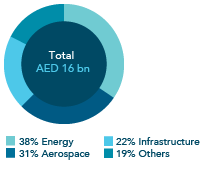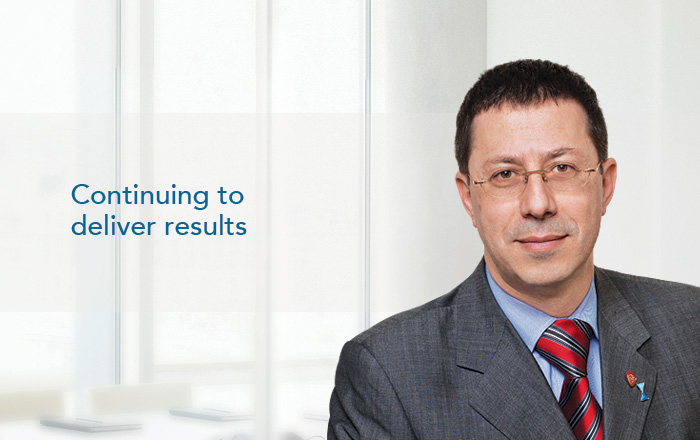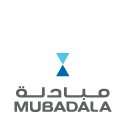Annual Report 2010
17.6 bn
101.5 bn
62.1 bn

Aa3 / AA / AA
Long-term
Moody’s / Standard & Poor’s / Fitch
P-1 / A-1+ / F1+
Short-term
Moody’s / Standard & Poor’s / Fitch
Chief Financial Officer's Message
Our strong operating performance during 2010 is reflected in the company’s consolidated financials, headlined by 22 percent year-on-year revenue growth, from AED 13.1 billion to AED 16 billion, and passing the AED 100 billion asset mark for the first time.

As in 2009, our three biggest contributing business units were Energy, Aerospace, and Infrastructure. However, our efforts to diversify revenues have also continued to deliver results.
For example, in 2008 Energy contributed 81 percent of total revenues, but by 2010 this proportion had reduced to 38 percent, with new revenue streams such as aircraft maintenance and social infrastructure respectively accounting for 31 percent and 22 percent of total income.
Certain aspects of our financial performance were negatively impacted by some of our publicly-held securities, with income from other investments falling from AED 4.2 billion to AED 1 billion, a drop in the value of our Aldar and AMD holdings offsetting the positive performance of our investments in Carlyle and GE.
The reduced investment return resulted in our operating income remaining unchanged at AED 17.6 billion, leading to a decrease in our profit for the year from AED 5 billion to AED 1.1 billion as our cost of sales of goods and services increased in line with the growth in revenues.
Total comprehensive income showed a loss of AED 315 million compared to 2009’s positive AED 8.9 billion, largely due to a negative mark-to-market valuation of our securities portfolio, including Aldar and AMD.
We anticipate that our earnings in the short and medium term may continue to be impacted by volatility in the global equity markets. Many of these equity stakes are part of our long-term investment strategy, and as an investor we manage our equity stakes for the long run, recognizing that there may be short-term volatility.
Our assets increased by 14 percent year-on-year from AED 88.9 billion to AED 101.5 billion – a significant achievement in passing AED 100 billion for the first time. Expansion of our asset base was driven by PP&E, loans and receivables, and prepayments, while cash and cash equivalents decreased from AED 11.8 billion to AED 6.3 billion as we continued to deploy capital into our asset portfolio.
Within PP&E, a 27 percent increase from AED 21.8 billion to AED 27.6 billion reflects a number of developments, including further progress of Sowwah Island, which is scheduled to become the Central Business District of Abu Dhabi; the completion and impending launch* of our first satellite, Yah1A, which will meet the demand for increasing government and commercial satellite-related services; the continued development of Masdar City as part of our renewable energy business; and the performance of SR Technics, a key part of our aircraft maintenance repair and overhaul business, which continues to demonstrate progress in achieving its business strategy and growth plans.
Loans were up from AED 1.3 billion to AED 11 billion due to the continued growth of our commercial finance joint venture with GE, Mubadala GE Capital, as well as our ongoing investment in affiliates and investee companies, including Emirates Aluminium (EMAL), Tabreed, Etisalat Nigeria, and AMMROC. Receivables and prepayments increased from AED 13 to AED 16.5 billion, mainly due to service concession receivables from Zayed University and Paris-Sorbonne University Abu Dhabi.
As we continue to grow and more capital is deployed into our projects, our total equity position for the year increased by 26 percent from AED 49.4 billion to AED 62.1 billion, driven by AED 13 billion of new Government equity compared to AED 8.9 billion in 2009.
The Group’s interest-bearing liabilities remained relatively stable year-on-year. Short-term debt decreased from AED 2.9 billion to AED 2 billion and long-term debt was AED 24 billion, in line with the 2009 position.
Our debt to equity ratio dropped year-on-year from 55 percent to 42 percent, with debt remaining stable while equity contributions increased. Similarly, our debt to capitalization decreased from 37 percent to 30 percent. Mubadala monitors leverage carefully, focusing on maintaining the optimal gearing relative to the composition of our portfolio rather than maximizing leverage.
Given Mubadala’s strong financial position and close relationship to our shareholder, the Government of Abu Dhabi, our credit ratings remain among the top corporate rankings in the Middle East – in the long-term category at Aa3/AA/AA and in the short term at P-1/A-1+/F1+ by Moody’s, Standard & Poor’s, and Fitch respectively.
Mubadala continued to diversify its funding base in 2010 with the establishment of our Euro Commercial Paper Programme and activity in the institutional private placement market. We also successfully refinanced our corporate revolving credit facility with 21 international financial institutions, increasing the size of the facility from US$2 billion to US$2.5 billion.
Since the year-end, and despite challenging market conditions, Mubadala has secured favorable financing for a number of projects, including the largest solar project financing in the form of a US$600 million, 22-year non-recourse facility for Shams; and a US$650 million syndicated loan facility for Etisalat Nigeria. We also raised US$750 million of 5-year and US$750 million of 10-year senior unsecured fixed rate corporate bonds, a US$180 million 20-year senior unsecured fixed rate corporate Yen bond, and continued to expand our Euro Commercial Paper Programme.
As our financial and operating performance for the year demonstrates, Mubadala continues to develop a strong portfolio of assets that will increasingly contribute to the diversification of our revenues and profits.
Carlos Obeid
Chief Financial Officer
